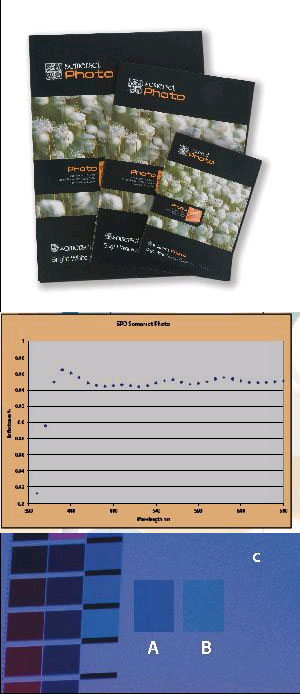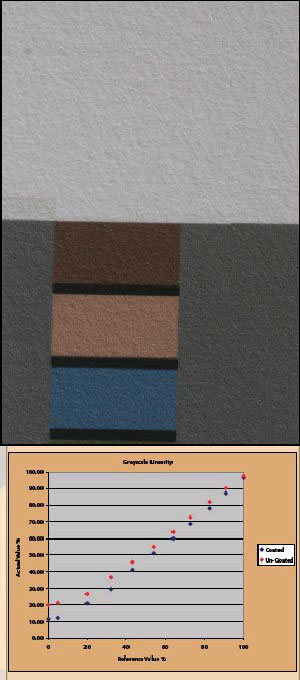articles/Paper/somersetphotopaper-page4
Paper Chase - Somerset Photo Paper - part 4 of 1 2 3 4 5 6 7
by Mike McNamee Published

Paper Chase - Somerset Photo Paper - Page 3
Somerset Photo is a new paper from St Cuthberts Mill in Wells, Somerset. It is a 100% alpha cellulose (cotton based) media that is acid free, mould made, weighing 300gsm, with a calliper of 520 microns. It is a very bright paper and the high brightness of 97.99% comes from quality materials rather than an over-application of optical brightening agents. This combination leaves the base white within a couple of tenths of pure neutral.
The paper has a weighty feel, important when prints are handled (carefully!) but retains a softness and flexibility. The surface texture is typical of a mould-made media using woollen felts, lightly textured but not perfectly smooth with a bit of character.
Claims that the material is low in OBAs are supported by our spectral data. There is a slight lift in the trace at 440mn wavelength but it does not project above 100% luminance the way that more heavily laden media would. When compared in the UV-booth, the material lies between, say, Hahnemuhle Museum Etching and Photo Rag (nearer to Photo Rag, in fact). You can see the difference in the photograph from the UV-booth - A is Museum Etching, B is Photo Rag and the background (C) is Somerset Photo.
Paper Feeding
We tested Somerset Photo on our Epson 3800 using Velvet Fine Art as the media setting and Matte Black ink. The driver called for the rear slot of the printer and full sheets loaded without any mis-feeds, although they needed a slight application of pressure to make them take-up every time. The other option would be to use the front slot which is designed for thick media.

Base Properties
The maximum black we achieved was 1.55 Dmax, equivalent to 19.7% on the Lab brightness scale. This is a full 9% deeper than we achieved with Somerset Velvet Enhanced, a material which always lagged behind its competitors in maximum density terms. At 20% it is slightly lighter than most of its competitors' maximum densities. Metamerism measured at 1.2 Lab ΔE (D65 to Tungsten A at 50% density) which is typical of Epson UltraChrome using Matte Black. In our audit colour chart the blacks progressed towards full density in a reasonably linear fashion until the 15RGB point, at which the shadows blocked. Somerset claim a Blue Wool Scale rating of 6 using Epson UltraChrome inks, so longevity should not be an issue.
Coating and Varnish
Although it may seem to many as an act of vandalism, we coated the media with varnish, and did before and after comparisons on the colour audit data. There was no sign of ink bleed after the application of a thick coat of satin varnish. The Dmax was raised from 1.55 to 1.92 and the colours were generally deeper and more saturated. If you wish to varnish using a gloss or satin water-based material then you should print a little lighter to begin with or make profiles from varnished targets
Please Note:
There is more than one page for this Article.
You are currently on page 4
- Paper Chase - Somerset Photo Paper page 1
- Paper Chase - Somerset Photo Paper page 2
- Paper Chase - Somerset Photo Paper page 3
- Paper Chase - Somerset Photo Paper page 4
- Paper Chase - Somerset Photo Paper page 5
- Paper Chase - Somerset Photo Paper page 6
- Paper Chase - Somerset Photo Paper page 7
1st Published
last update 09/12/2022 14:59:07
More Paper Articles
There are 0 days to get ready for The Society of Photographers Convention and Trade Show at The Novotel London West, Hammersmith ...
which starts on Wednesday 15th January 2025




